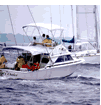
Pollutants from marinas and recreational boating are more likely to adversely affect water quality because of their location overwater or at the water’s edge. When boating and related activities (e.g., marinas and boat maintenance areas) are poorly planned or managed, they may threaten the health of aquatic systems and pose other environmental hazards. These Management Measures are intended to reduce impacts on water quality and aquatic habitat from marina siting and construction (new and expanding marinas), and marina and boat operation and maintenance.
These Management Measures pertain to:
Management Measures in the Marina Siting and Design section are intended to be used by marina owners and operators when marinas (including mooring fields, boat maintenance yards, boat ramps, boats slips, and docks) are in the planning phase of development. The Operations and Maintenance section contains Management Measures intended for boaters as well as for marina operators and harbormasters.
Descriptions of this land use category and its Management Measures are adapted from California’s NPS Encyclopedia. More Info

Site and design new and expanding marinas such that tides and/or currents will aid in flushing the site or renew its water regularly. These practices can reduce the potential for water stagnation, maintain biological productivity, and reduce the potential for toxic accumulation in bottom sediment. More Info
Site and design new and expanding marinas to protect against adverse effects on shellfish resources, wetlands, submerged aquatic vegetation, or other important riparian and aquatic habitat areas as designated by local, State, or federal governments. More Info


Assess water quality as a part of the siting and design of new and expanding marinas to establish baseline water quality conditions or trends. Also assess water quality at existing marinas to establish baseline water quality conditions. More Info
Where streambank or shoreline erosion is a NPS pollution problem, streambanks/shorelines should be stabilized. The use of vegetative stabilization methods is preferred over the use of structural stabilization methods, if appropriate. More Info


Implement effective runoff control strategies, which include the use of pollution prevention activities and the proper design of marinas and boat maintenance areas (including parking areas). Reduce the average annual loadings of total suspended solids (TSS) in runoff from these areas to meet water quality objectives. More Info
Design existing and proposed fueling stations to allow for spill prevention and for ease in cleanup of spills that may occur. More Info


Install pump-out, dump station, and restroom facilities where needed at new and expanding and existing marinas to reduce the release of sewage to surface waters. Design these facilities to allow ease of access and post signage to promote use by the boating public. More Info
Install facilities where needed for the proper recycling or disposal of solid wastes (such as oil filters, lead acid batteries, used absorbent pads, spent zinc anodes, and fish waste) and liquid materials (such as fuel, oil, solvents, antifreeze, and paints) generated by users of marinas and boat maintenance areas. Design these facilities to allow ease of access, post signage to promote use by the boating public, and encourage recycling to the fullest extent possible. More Info


Properly dispose of solid wastes produced by the operation, cleaning, maintenance, and repair of boats and operation of marinas, and encourage recycling of recyclable materials to the fullest extent possible, to limit entry of solid wastes to surface waters. Also promote sound fish waste management through a combination of fish-cleaning restrictions, public education, and proper disposal of fish waste. More Info
Provide and maintain appropriate storage, transfer, containment, and disposal facilities for liquid materials (such as fuel, oil, solvents, antifreeze, and paints) and encourage recycling of these materials to the fullest extent possible. Encourage the proper disposal of gray water. More Info


Reduce the amount of fuel and oil from boat bilges and fuel tank air vents entering marina and surface waters. More Info
For boats that are in the water, perform topside cleaning and boat maintenance operations to minimize, to the extent practicable, the release to surface waters of harmful products such as cleaners, solvents, paint sandings, and paint flakes. More Info


Ensure that sewage pump-out facilities are maintained in operational condition and encourage their use. Also enforce the proper use of marine sanitation devices (MSD). More Info
Restrict boating activities where necessary to decrease turbidity and physical destruction of shallow-water habitat. Also prevent erosion of shorelines and stream channels by reducing boat wakes. More Info


Implement educational programs to raise awareness about what marinas are doing to prevent adverse impacts to surface waters and groundwater. Public education and outreach programs should involve the community (e.g., waterfront agencies, boat-related service providers, environmental groups, surfers, swimmers, and fisherman). More Info